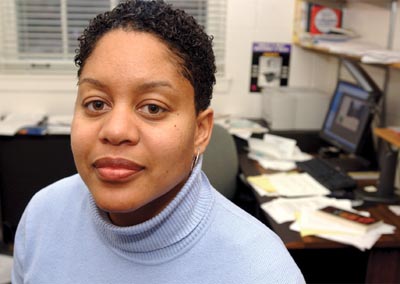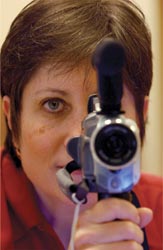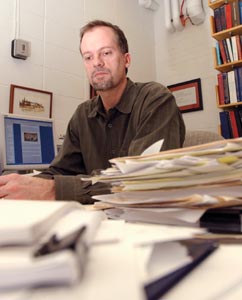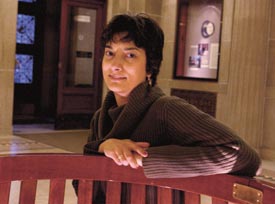

InSite Sources
Rochester helps lead the development of an electronic repository for faculty
to make their scholarly work accessible to colleagues, students, and the public.
By Scott Hauser | Photography by Richard Baker
 |
| WRITE TIME: Valeria Sinclair-Chapman, assistant professor of political science, says she frequently trades e-mail attachments and computer discs with colleagues when they are working on projects together, but she prefers to meet in person whenever possible. |
Valeria Sinclair-Chapman keeps the evidence of her life as a scholar right at her fingertips. The assistant professor’s office in Harkness Hall is filled with the tangible results of her interests in legislative politics, political participation among African Americans, and other topics in American political science.
Where’s my Data?
 |
| WORK STUDY: Anthropologist Nancy Foster used a video camera to record interviews with faculty members about how they organize their working lives, believed to be the first such work-practice study focused on scholars at a research university. |
Not only are faculty an intelligent group of people who are dedicated to advancing knowledge in their fields, they also are quite clever at finding ways to use technology so that their scholarly efforts don’t disappear, says Nancy Foster, an anthropologist who has done several studies of how people do their work.
Foster, who explored some of the reasons keeping faculty from using the new repository, says scholars are not indifferent to making their work available and preserving it for the future.
But they don’t want to spend a lot of time worrying about the nuts-and-bolts of how software works or learning new software every few years as programs are upgraded or go out-of-date.
“Faculty really just want to do their research,” Foster says. “They want the tools to work well, but they really don’t care what kinds of tools they are. In retrospect, that sounds totally obvious, but it was important to document.”
As part of the project, Foster spent six months interviewing Rochester scholars from the sciences, social sciences, and humanities about the ways that they create, store, revise, and share their work. The results have helped the Rochester team create a more user-oriented version of the repository that addresses many of the concerns faculty have about using an online archive.
Foster and digital initiatives manager David Lindahl recently presented a partial list of Web-based services faculty are looking for in archives. The list included access to their own work from different computers; a truly safe place for their data and documents; more order and less chaos in their personal cyberspace; easy online access to dissertations; the ability to share their own work in progress; support for writing with other authors; and an easy way to share finished work.
Like other users, professors get frustrated when they lose documents, experience glitches when they share materials, and mix up documents when they look for the latest edited version, Foster says.
While some academic communities, particularly in the sciences, have devised ways to share information electronically, many faculty have developed their own elaborate workarounds to make sure their data stays safe.
Some keep multiple copies on their work and home computers, some send copies to relatives in distant cities for safekeeping, and some spend hours organizing their files to make sure they have a copy of the most recent version.
“They’re not doing these workarounds because they’ve never had a problem,” Foster says. “When you start to see the weird things that they’re doing, then you start to see what their true needs are.”
A well-planned and well-maintained digital archive can address the concerns of scholars if planners keep faculty needs in mind, Foster says.
“We know we have to have something,” Foster says. “If you don’t preserve it so that you can use it through digital repositories, what are you going to use?
“The alternative is losing valuable scholarly work.”
—Scott Hauser
The piles of papers and printouts—a rough draft here, a dataset there—are neatly organized and arranged, each stack roughly corresponding to a work in progress.
“It’s mostly in 10 various stacks,” Sinclair-Chapman says when a visitor asks how she keeps her working life organized. “That’s one book project. That’s the research for another book project. This is future research ideas. This is a class that I’m teaching. Behind you are papers from a class. I know where my stacks are, and the filing cabinet is full of things.”
One place she doesn’t immediately point to is her computer, which, like most faculty workstations, connects to the University’s high-speed computer network and out to the ever-expanding world of cyberspace.
While nearly all the accumulated materials—papers written by her, her collected research, rough drafts, course syllabi, Internet search results—have an electronic life on Sinclair-Chapman’s hard drive, the information is inaccessible to anyone but her and a few colleagues with whom she corresponds.
To information mavens like Susan Gibbons, assistant dean for public services and collection development at the River Campus Libraries, the computer next to Sinclair-Chapman’s desk—along with each of the computers used by the 1,000 or so other faculty on campus—represents a small scholarly trove.
Filled with digital versions of published books, drafts of manuscripts, papers delivered at conferences, lectures given to students, and files of research materials, they provide an electronic window on an otherwise invisible world of academic work at Rochester.
What if there were a way to make some of that “unseen” scholarly activity accessible to scholars, students, policy makers, and others around the world? What if the library could gather the work of Rochester’s scholars and make it available to the outside world?
“There’s all this great informal scholarly communication going
on,” Gibbons says. “Until recently, there was no way for the University
to provide a service where faculty could deposit this into a place where it
would be kept safe, where it could be accessible to others if they wanted it
to be, and where it would be easy for other people to find it.
“This great stuff was locked up on hard drives.”
Unlocking some of that information is the goal behind a new initiative at Rochester to create what’s known as an “institutional repository” or a “digital archive,” an electronic home where faculty can deposit materials that they want to make available to others.
In turn, researchers inside and outside the University would be able to access high quality, scholarly material that can be searched, downloaded, commented upon, linked to—and perhaps, most important—cited by scholars and others interested in the work.
To borrow a metaphor from the Chronicle of Higher Education, such a repository could provide professors a way to find scholastic research as easily as their students search for MP3 files.
“It’s a very new role for libraries,” says Gibbons, who is part of a team of information specialists, computer scientists, Web developers, and usability experts working on the project. “With an institutional repository, our focus is turned toward the intellectual content that’s being produced on campus, finding a way to bring it all together and take care of it so that the rest of the world can get at it. It’s a very different mission for libraries.”
It’s a mission that has grown along with the digital revolution of the late 20th and early 21st centuries. Anyone who still has pieces of a past academic life stored on 5.25-inch floppy discs, or whose attempt to retrieve old files has reached a dead end because the software needed to open them no longer exists, understands how quickly state of the art turns into obsolescence.
Add to that the blossoming thicket of the Internet and the Web, where—even with powerful search tools like Google—it’s difficult to know what’s worth reading, never mind citing. When online searches return several thousand hits, having a way to judge a site’s information—for example, if one of the listings indicated it came from an archive maintained by the University—would provide a rough-and-ready guide to quality and reliability.
And having Rochester’s name pop up more often would be a bonus, too.
“That’s how you get famous—you get cited,” says University Provost Charles E. Phelps, a longtime advocate for finding ways to take advantage of electronic technology in academic scholarship and the chief administrative architect behind Rochester’s initiative.
The easy searchability, along with the need to preserve digital information, means electronic repositories are increasingly becoming priorities for universities like Rochester, Phelps says.
Since the late 1990s, several such initiatives have been under way. At Rochester, the effort is based on open- source software called DSpace, which has been developed by researchers from MIT and Hewlett-Packard.
In 2003, MIT asked a handful of top institutions—in addition to Rochester, the list included Columbia, Cornell, and Ohio State universities, along with the University of Toronto, the University of Washington, and the University of Cambridge—to join the “DSpace Federation,” a task force to test drive and fine-tune the software.
 |
| DISCIPLINE SPECIFIC: Steve Manly, associate professor of physics and astronomy, says each academic discipline has its own culture when it comes to making scholarly materials accessible online. |
Kind of like an electronic curriculum vita, the Rochester site, which has been renamed UR Research (http://urresearch.rochester.edu), allows faculty to set up online areas where they can post whatever they think will give others a sense of the work that they do. While the site is similar to personal or departmental Web sites that many faculty have long maintained, there is a key difference. Once files are stored on the site, the library takes on the responsibility of making sure the information remains accessible, freeing faculty from the burden of having to update and maintain their own sites.
The initiative also includes an effort to ensure that the information posted adheres to copyright rules and to make sure that by putting their material on the site—either work that has been published or that is not yet published—faculty are not limiting their ability to have their work published in journals or elsewhere.
The repository includes submissions from departments across all three campuses in a range of file formats, including multimedia files like sound and video recordings. In 2004, the site had more than 15,000 download requests, and only 7 of the top 50 requests came from inside the University.
‘Gray Literature’
Christine Gunlogson knows that academic conferences can be vital in her efforts to stay up-to-date as an assistant professor of linguistics who specializes in the fields of pragmatics and semantics.
But she realizes it’s not always possible to travel halfway around the world to attend a conference, even if she’s intrigued by a paper that’s going to be presented.
“Often I’ll think, ‘Wow, the title and the abstract for the paper look great,’” Gunlogson says, “But I’m not going to fly to Amsterdam to learn more about it.”
Conference proceedings—the summation of lectures, presented papers, and discussions that take place at academic gatherings—are one of the prime examples of the kinds of scholarly literature that often goes unarchived in academia, say librarians and information specialists putting together Rochester’s electronic repository. Known as “gray literature,” such scholarly work exists in electronic form but never appears as a book or in a journal.
“This is important material,” says Susan Gibbons, one of the members of Rochester’s digital archive initiative. “But there’s often no mechanism to make it widely available.”
Another important example includes Ph.D. dissertations. Doctoral students are required to submit printed copies of their final theses for the library’s collections, but rare is the student scholarship that doesn’t exist electronically—somewhere.
Until recently the only way to see the contents of a particular dissertation
was to write to a library, ask for a copy to be made, and pay for the printing
and postage. Even in the Internet age, it’s hit-and-miss whether a thesis
will be available in a form that can be
e-mailed or downloaded.
Steve Manly, the Mercer Brugler Distinguished Teaching Professor in the Department of Physics and Astronomy, says student work often can be an important source for research, but he’s reluctant to wait several weeks to have a copy sent to him.
If he has to jump through too many hoops, he looks elsewhere.
“I want to be able press that button, get that electronic copy, and press print, and read it, or pull it up on my screen and find what I need,” he says. “If I cannot find it, if I have to write a letter, or make a phone call to some university and order it, and if it’s going to show up any later than this evening, I will simply go somewhere else for that information.
“It’s truly the exception that I will go out of my way to get that particular thesis.”
—Scott Hauser
The collection is off to a good start, Gibbons says, but it represents only a fraction of the rich store of information available on campus. Finding better ways to get faculty to use the site has been one of the major contributions of the Rochester team to the DSpace initiative and to the cause of institutional repositories in general.
The team added anthropologist Nancy Foster to conduct what’s believed to be the first work-practice study aimed at understanding how faculty do their scholarly work.
“We assumed that we didn’t really know what faculty members needed,” Foster says. “Our approach was to study how they do their work and, by that route, discover their needs.”
One of the major findings has been appreciating the difference between what professors want to do as scholars and how they do it. Faculty, Foster says, care deeply about making their work available to others, particularly colleagues, but they have little time or interest in learning the underpinnings behind technological tools. For example, to librarians, an important key to making information accessible is cataloging it properly. In order to do that, the materials have to be assigned descriptive terms known as metadata, one of the first bits of information that search engines look for.
“Do faculty care about metadata? No,” Foster says. “Do they care about other people finding their work? Totally. And not just finding their work, but using it and citing it.
“That’s what they really care about: They want to do their work, they want other people to read it and cite it, so that other people can make progress in the field. That’s their real thrill.”
Foster also found that faculty have devised creative ways to save their work and to share it with colleagues. As technological tools have developed and morphed over the years, scholars have adopted a variety of practices to make their research accessible.
Steve Manly, associate professor of physics and astronomy, says electronic archives have long been an important part of the way physicists stay up-to-date in their fields, and collaborations using the Web are common. Manly, for example, maintains a site that he and his students rely on throughout the school year.
In high-energy physics, scientists who are ready to submit papers to the leading journals frequently post preprint versions on a site called arXiv. Administered by Cornell, the site is considered so important that physicists log on regularly, if not daily, to see the latest postings.
“It’s the fastest way to get a paper out there,” Manly says. “Anybody who wants the latest result, that’s where they go.”
He acknowledges that different disciplines have developed different cultures when it comes to electronic scholarship. At one extreme are many of the sciences such as physics, where even prestigious journals understand that the articles submitted for publication most likely exist in an earlier online form.
Manly doubts that an institutional archive will be able to supplant discipline-specific sites like arXiv, which is recognized as a citable reference for other researchers until a printed version of the work appears in a journal.
But he says efforts to make Rochester work accessible are beneficial in the long run.
“Citations are the currency—a measure in some sense—of our impact in our fields,” he says. “If you consider them very carefully, they can be a legitimate measure. If the citation numbers skyrocket, that’s getting the University’s name out there, and it’s getting the name out there in a good way. It’s getting the name out there in a way that’s associated with research.”
Christine Gunlogson, assistant professor of linguistics, says scholars like her who are interested in semantics and pragmatics also have developed specialized electronic mailing lists and online listings to share information. While she has a site within the University’s repository, she will continue to keep track of those resources.
 |
| NEW ROLE: Electronic repositories gather campus scholarship and make it available to users. That’s a new role for the libraries, which traditionally have gathered scholarship from outside the University for use on campus, says Susan Gibbons, an assistant dean at the River Campus Libraries. |
But she says she’s intrigued by other aspects of the University repository, such as the idea that the address for files in the archive will remain consistent over time, doing away with a problem that Web users frequently encounter as sites go out of business or get reorganized.
She also likes the notion of keeping multimedia files online. One of her main areas of research is how people formulate questions, a process that requires listening closely to intonation.
“You can transcribe it, but it’s nice to be able to hear it, too,” Gunlogson says. “Potentially, you could accompany manuscripts with sound files.”
Foster says that regardless of what kinds of files faculty decide to share in the repository, the ultimate goal is to make sure the information is preserved and shared.
The Research Files
For more about the Rochester repository, visit http://urresearch.rochester.edu.
That doesn’t mean that paper copies—or the use of paper as the lingua franca technology of scholarly work—is going to disappear any time soon.
Sinclair-Chapman, who admits she’s printed more than her share of copies while working on a project, appreciates that.
“There’s something that I like about handling paper that an electronic environment could never replicate,” she says.
But she says she’s happy that the library is willing to help keep her work at the fingertips of other people.
“The writing that I do is my life’s blood.”
Scott Hauser is editor of Rochester Review.
